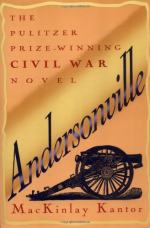CHAPTER XXV.
The “Plymouth pilgrims”—Sad transition from comfortable barracks to Andersonville—A crazed Pennsylvanian—development of the Butler business.
We awoke one morning, in the last part of April, to find about two thousand freshly arrived prisoners lying asleep in the main streets running from the gates. They were attired in stylish new uniforms, with fancy hats and shoes; the Sergeants and Corporals wore patent leather or silk chevrons, and each man had a large, well-filled knapsack, of the kind new recruits usually carried on coming first to the front, and which the older soldiers spoke of humorously as “bureaus.” They were the snuggest, nattiest lot of soldiers we had ever seen, outside of the “paper collar” fellows forming the headquarter guard of some General in a large City. As one of my companions surveyed them, he said:
“Hulloa! I’m blanked if the Johnnies haven’t caught a regiment of Brigadier Generals, somewhere.”
By-and-by the “fresh fish,” as all new arrivals were termed, began to wake up, and then we learned that they belonged to a brigade consisting of the Eighty-Fifth New York, One Hundred and First and One Hundred and Third Pennsylvania, Sixteenth Connecticut, Twenty-Fourth New York Battery, two companies of Massachusetts heavy artillery, and a company of the Twelfth New York Cavalry.
They had been garrisoning Plymouth, N. C., an important seaport on the Roanoke River. Three small gunboats assisted them in their duty. The Rebels constructed a powerful iron clad called the “Albemarle,” at a point further up the Roanoke, and on the afternoon of the 17th, with her and three brigades of infantry, made an attack upon the post. The “Albemarle” ran past the forts unharmed, sank one of the gunboats, and drove the others away. She then turned her attention to the garrison, which she took in the rear, while the infantry attacked in front. Our men held out until the 20th, when they capitulated. They were allowed to retain their personal effects, of all kinds, and, as is the case with all men in garrison, these were considerable.
The One Hundred and First and One Hundred and Third Pennsylvania and Eighty-Fifth New York had just “veteranized,” and received their first instalment of veteran bounty. Had they not been attacked they would have sailed for home in a day or two, on their veteran furlough, and this accounted for their fine raiment. They were made up of boys from good New York and Pennsylvania families, and were, as a rule, intelligent and fairly educated.




